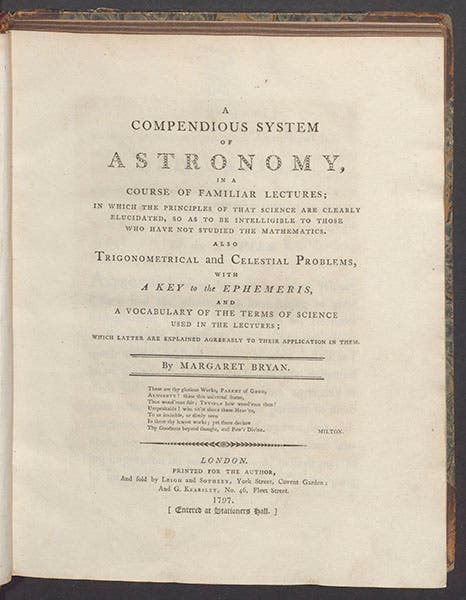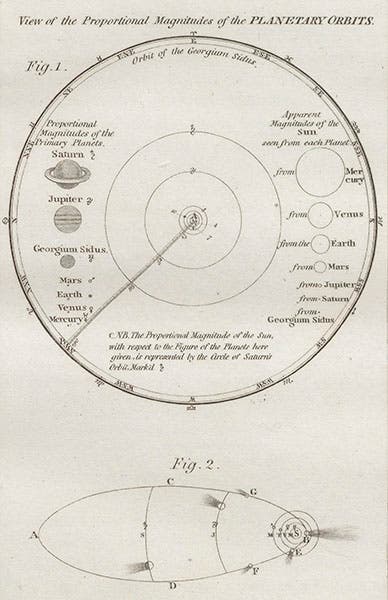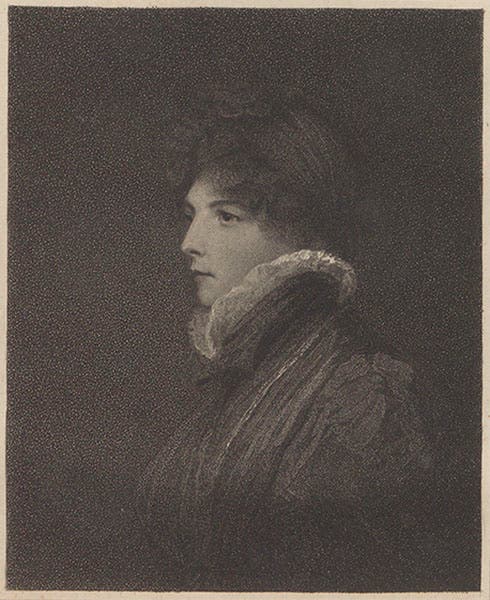Scientist of the Day - Margaret Bryan
On Jan. 6, 1797, Charles Hutton, a well-respected British mathematician, wrote a letter to a young woman in London, Margaret Bryan. Mrs. Bryan had written a textbook on astronomy for young women; it was still in manuscript, and she had sent it to Hutton for his perusal. Hutton replied: I herewith return the ingenious MS. of Astronomical Lectures you favored me with the sight of, which I have read over with great pleasure; and the more so, to find that even the learned and more difficult Sciences are thus beginning to be successfully cultivated by the extraordinary and elegant talents of the female writers of the present day. Should you, Madam, give to your friends and to the public to benefit by the publication of these your learned and useful labours, I beg to have the honor of being considered one of the encouragers of so useful a work; Your most obedient, and most humble servant, Charles Hutton
Margaret was so pleased with Hutton’s comments that she had the book printed before the year was out, and it appeared as A Compendious System of Astronomy late in 1797 (second image). Hutton's letter of praise was printed and dated at the end of the preface, which is why we know about it. This is a handsome book, with expensive engravings of instruments and physical phenomena (third and fourth images), but by far the handsomest plate is the frontispiece, which depicts Mrs. Bryan and her two daughters. If that isn't the loveliest family portrait to appear in any scientific book, even without Mr. Bryan, I would like to know its equal.
But the most curious thing about Mrs. Bryan is that we (the history of science community) know practically nothing about her. We have no idea when or where she was born, or when she died. The first date we have for her is 1797, the date of Hutton's letter and the publication of her first book. We know that the book was reprinted in octavo format in 1800 and 1805 (the extraordinary portrait lost all its charm in the reduction), and that Mrs. Bryan published another book in 1806, called Lectures on Natural Philosophy (fifth image). We know she ran a girls’ school, because she told us so in the Compendious System, which she dedicated to her pupils. The school was at first in Blackheath, and then in central London. She published one more book in 1815, and then all traces of her vanish. We know nothing about Mr. Bryan, although there has been a guess that he was a barrister.
Certainly the family had at least a modest amount of wealth, as the 1806 portrait was painted by Samuel Shelley and engraved in aquatint by William Nutter, both noted portraitists in London whose services did not come cheaply. Mrs. Bryan must have had some social standing, as the Compendious System was published by subscription. The subscription list is printed at the beginning of the book, and it is a socially impressive list, including the Archbishop of Canterbury and the Astronomer Royal of England among the hundreds of subscribers. And Margaret Bryan was clearly intelligent, as even the most cursory perusal of the text indicates.
So how could this handsome, talented woman, who offered a scientific education to thousands of young girls, at a time when young women were often not introduced to science at all – how could this impressive candidate for inclusion in any survey of Women in Science disappear so thoroughly from the historical record? It is truly a mystery, but it is a mystery that might be solved one day, if the right archive were looked into by the right person. I hope this comes to pass, as we would all like to know more about the enigmatic Mrs. Bryan.
As you have probably gathered, we have a respectable Margaret Bryan collection at the Library. We have the 1797 and 1805 editions of the Compendious System, and the 1806 (and only) edition of the Lectures on Natural Philosophy. The latter work also has a frontispiece portrait, this time of Mrs. Bryan alone, and she appears as attractively intelligent here as in the family portrait (sixth image).
So if you were wondering why we celebrate the date of a letter today, rather than a birthday or a death date, there you have it. Jan. 6 is the only calendar date extant that is associated with Mrs. Bryan, and if that letter were not dated, we would never be able to celebrate her in these anniversaries at all. It was nice of Charles Hutton to give Margaret Bryan the courage to publish her book, and us the occasion to commemorate her life. Dr. William B. Ashworth, Jr., Consultant for the History of Science, Linda Hall Library and Associate Professor emeritus, Department of History, University of Missouri-Kansas City. Comments or corrections are welcome; please direct to ashworthw@umkc.edu.












